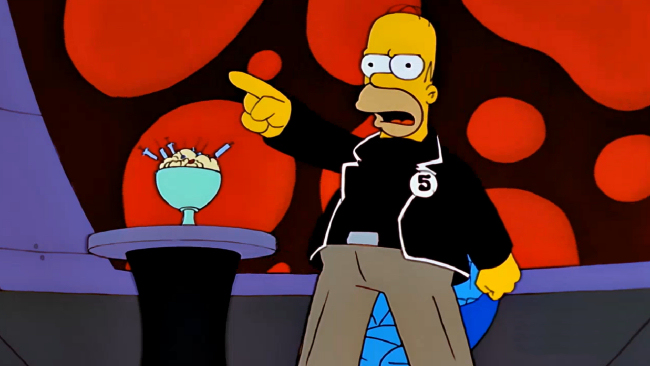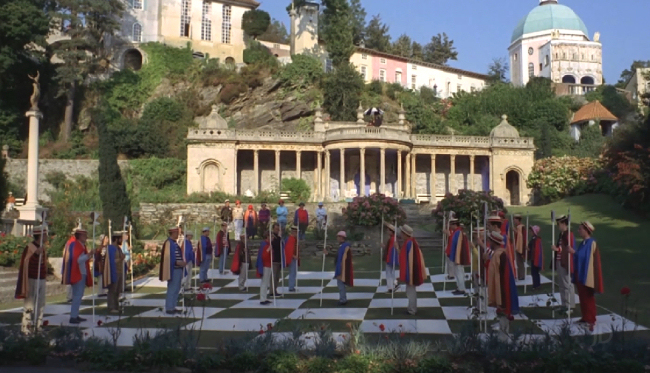The Simpsons: The Computer Wore Menace Shoes
"The Island" vs. "The Village"
The Prisoner References Explained
Getting all O.C.D. so that YOU don't have to!
by J.DeFelice
The Prisoner References Explained
Getting all O.C.D. so that YOU don't have to!
by J.DeFelice
In episode #254 (S12/E6 2000), Homer Simpson buys his first computer (which Lisa has to set up for him after his own failed attempts), and builds a website. No one looks at it, so in order to get "hits", he starts to post local gossip. But when he runs out of gossip, he starts to make up his own "facts" (aka: "bull plop"). This results in his being kidnapped from the Kwik-E-Mart via truck and brought to a place called "The Island". Some strange, anonymous group thinks he knows all about their nefarious use of flu shots on the public (which results in people shopping during Christmas time).
 While on The Island, Homer is given a number, Five, and meets a man named Number Six. Everyone there has a number-badge on them. And they are also there because they "know too much".
While on The Island, Homer is given a number, Five, and meets a man named Number Six. Everyone there has a number-badge on them. And they are also there because they "know too much".
Meanwhile, a fake Homer (with a German accent and growing hair) is sent to this home to try and make it seem like he hasn't been kidnapped.
After being gassed (drugged?) over and over, Homer finally talks to the head man on the island, then tries to figure out just how he can escape. Eventually, Number Six appears and shows Homer his homemade raft. While a proud Six rambles on about the raft, Homer pushes him into the water and steals it. As he sails off, an evil white orb emerges from the water and pursues him. Homer pops it with a plastic fork, then continues homeward, supposedly after four months.
In the end, the whole Simpson family ends up on The Island.
To many, the second half of this episode makes NO sense. So I'd like to help folks out a little with this visual explanation.
To Begin With...
"The Island" is a reference to "The Village" of the 1967-68 British television show The Prisoner, starring, produced by, sometimes written & directed by Patrick McGoohan. Number Six is, in fact, voiced by the man himself, and it is the only time he reprised the role that gained him cult status worldwide. Much has been written about The Prisoner, but this post is for those Simpsons fans out there who are not interested in doing research into that show.
NOTE: I have never watched the show "Fantasy Island" (1977-1984), so it is possible some references, like the koala and penguin, are from there. The penguin is supposed to Willie the Kool Cigarette mascot, and the peacock the NBC mascot.
NOTE: I have never watched the show "Fantasy Island" (1977-1984), so it is possible some references, like the koala and penguin, are from there. The penguin is supposed to Willie the Kool Cigarette mascot, and the peacock the NBC mascot.
#1: The Truck (aka: Fake Kwik-E-Mart)
This is the truck that Homer is kidnapped with. Inside, it is made to look like the real Kwik-E-Mart, complete with a cardboard Apu.
In the final Prisoner episode, "Fall Out", Number Six and his "friends" finally escape The Village... in what looks like a jail cell (first used in the episode "Once Upon a Time") that is actually the trailer of a truck.
Another view from "Fall Out"... the truck carrying the "prisoners" makes it's way through London.
#2: The Gas
Homer is constantly being gassed while on The Island.
In the opening credits of The Prisoner, we see an un-named spy, the man who becomes, simply, Number Six, resign in his bosses office. He drives back to his London flat, and as he packs his bags for a trip, he is gassed and passes out.
... when he awakens, he is in "The Village", which may or may not be on an unknown island, as at times it seems to be connected to land, though no one seems to try to escape it via land... until the last episode! Here we see Number Six passed out from "the gas".
#3: The Island
This is "The Island" that Homer is sent to...
... and this is the location where The Prisoner was based, called Portmeirion. It is a tourist village in Gwynedd, North Wales, designed and built by Sir Clough Williams-Ellis between 1925 and 1975 in the style of an Italian village. (from "Many Happy Returns")
#4: The Woman in the Cape
Number Six tells Homer (as Number 5) that people on The Island are there because they "know too much". Here we see Number 27, who knows how to turn water into gasoline.
Number 27 seems to be based on Number 9 from "Arrival".
Two more examples of "the cape".
#5: The Bald Guy in the Round Chair
Homer talks to a bald guy in a strange round chair, who appears to be in charge...
... referring to the character of Number 2, played by different actors each week (with one repeat by Leo McKern). Number 2 runs The Village, and reports only to the mysterious and rarely mentioned Number One.
#6: The Lava Lamp (w/frog)
There is a frog swimming in Bald Guy's lava lamp... Notice Number 6 also has a lava lamp!
#6.5: The Lava Wall
The lava-lamp wall behind Homer...
... just like in the first episode of The Prisoner, on the wall of Number 2's "office".
Homer getting mad with the lava-wall behind him... and bowl of drugged ice cream...
... Number 6 getting mad at Number 2 with lava-wall in the background (same episode).
#7: The Croquet Game
Homer tries to fit in by playing a game of croquet with other "islanders".
Number 6 playing human-chess with other Villagers. Notice the accuracy of the background.
Side view of the chess "board".
#8: The Raft
Number 6 tells Homer that he has been working on something for 33 years... a raft made out of "toilet paper rolls, toothpicks, and plastic forks... and the sail is made of scabs (??) and dynamite... it's small and it's smelly, but it should carry both of us to..." ... before he can finish, Homer knocks Six into the water and steals the raft!
Here is Number 6's first "raft" from the episode "Chimes of Big Ben"... more of a mini sail boat, really. As you can see, it didn't completely work out, though they did get a distance away from the Village... for a while...
Raft #2 from "Checkmate", at first used to transmit radio signals, then used by Number 6 to get out onto a boat he thinks will help him escape.
Raft #3 from "Many Happy Returns". Number 6 actually escaped with this one! (Or DID he?) He is on this raft for 25 days, before ending up on a boat with some gun-running bad guys. Of course, Six overpowers them and takes their boat close to land before having to abandon ship and swim. Here we see him testing his sail...
... checking his his supplies before casting off...
... and having a shave early in the cruise. Alas, though Six thinks he finally gets back to London, it's all a ploy, and he finds himself once again a Prisoner in the Village.
#9: The Anti-Escape Orb
Almost immediately after leaving the island, Homer is pursued by an "anti-escape orb". This is a reference to the "Rover" used as a sort of spy/security-guard in The Prisoner. As silly as it looks, it was deadly to anyone trying to escape the Village. Or simply be their own person...
The orb emerges from the sea...
... Rover emerges from the sea... ("Checkmate")
Anti-escape orb pursues Homer and "his" raft.
Rover directing Number 6 back to the Village after almost escaping via boat ("Checkmate")
The bad guys watch Homer sail away after he effortlessly "kills" the orb with a plastic fork.
Number Two watches Rover directing Number 6 back to the Village.
Poor Number Six had almost as bad a time with Rover as Patrick McGoohan and his crew did!
#10: MISCELLANEOUS
Angry Number Six...
After being pushed into the water by Homer, Number 6 emerges, sees his raft sailing away, and angrily comments that this is the third time that had happened to him.
Number Six's Accent
While in the water, notice the way he pronounces the word "third"... more like "t'urd". This is supposedly what Patrick McGoohan's "natural" voice sounded like.
On screen, McGoohan had a rather unique speech pattern and tone to his voice. He usually sounded rather classy and eloquent. Though when the first season of "Danger Man/Secret Agent" aired on television, he played an American NATO security agent, and never did seem to settle on one accent. You could pick up bits of Irish and British along with the put-on Yank accent, depending on the episode.
Though he was born in New York, his Irish parents moved the family back to their native Ireland when he was less than a year old, so there was no New York influence in play. He spent the beginning of his childhood on the family farm before they made the move to England. He did not go to any formal acting school, so probably did not have had any one speech style drilled into him for use on the stage. After The Prisoner ended, McGoohan and his family moved to Switzerland, then finally to America where he stayed until his death in 2009. So trying to pin-point his accent in any particular role can be exasperating!
33 years...
This episode aired in the year 2000. So 33 years prior would be 1967, which is indeed the year The Prisoner premiered.
The third time...
That doesn't really make sense, as he said that particular raft took him 33 years to make. Did he make others along with it?
Number badges...
Though Number Six wears his number badge all through the Simpsons episode, during The Prisoner he only wore it three times: very briefly after it is issued to him in "The Arrival" (he promptly removes it and throws it away), in "Free For All" (a campaign ribbon while running for the position of Number 2), and in "Schizoid Man", where things get complicated due to Six having a double.
 |
| Which Six is which? |
Not a number...
Homer gets angry a lot and says things like he is "not a number". This is, of course, the line heard in the opening credits of The Prisoner, and basically sums up the whole show: "I am not a number, I am a free man!". The anger and throwing of things at Bald Guy are no doubt references to when McGoohan allowed Number Six's temper to flare... maybe even to his own temper during production.
Obviously, Number Six never had a line like "I want answers now or I want them eventually!"
Obviously, Number Six never had a line like "I want answers now or I want them eventually!"
Fighting your duplicate...
Back at his house, Homer strangles fake-Homer... or is that the other way around?
Fake Number Six fights the real Number Six... wait, no, that's the REAL Number Six trying to get information out of the FAKE Number Six... I think... (from Schizoid Man)
(J.DeFelice 2020)


















































